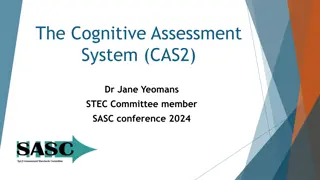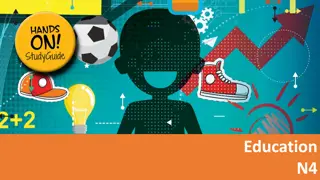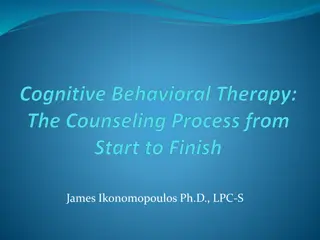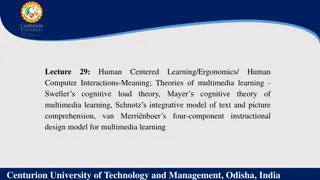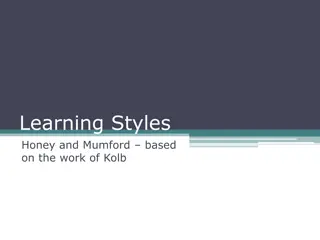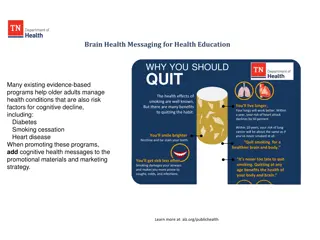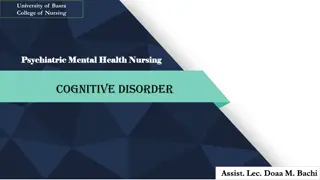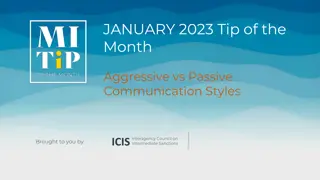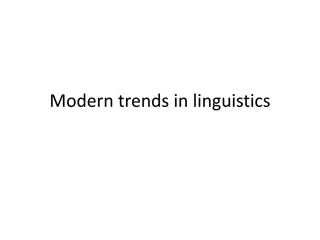Understanding Cognitive Styles and Learning Styles in Education
Cognitive styles explore an individual's preferred way of thinking and problem-solving, while learning styles delve into how individuals acquire and process information. These styles influence attitudes, values, and social interactions. By understanding one's own cognitive and learning styles, one can optimize their learning process effectively. Learning styles encompass various approaches to learning, allowing for flexibility in strategies based on individual preferences.
Download Presentation

Please find below an Image/Link to download the presentation.
The content on the website is provided AS IS for your information and personal use only. It may not be sold, licensed, or shared on other websites without obtaining consent from the author. Download presentation by click this link. If you encounter any issues during the download, it is possible that the publisher has removed the file from their server.
E N D
Presentation Transcript
Cognitive Styles and Learning Styles Cognitive Styles and Learning Styles By Dr. Ajit Mondal Assistant Professor, Department of Education West Bengal State University
Cognitive style is an area of psychology which investigates the preferred style of thinking and problem-solving an individual may have. Cognitive style is also defined in a range of different ways, as: a certain approach to problem-solving, based on intellectual schemes of thought; individual characteristics of cognitive processing which are peculiar to a particular individual; a person s typical approach to learning activities and problem-solving; strategies, or regular mental behaviours, habitually applied by an individual to problem-solving.
Cognitive styles describe how the individual acquires knowledge (cognition) and processes information (conceptualization). Cognitive styles are related to mental behaviors which individuals apply habitually when they are solving problems.
Cognitive style is usually described as a stable and persistent personality dimension which influences attitudes, values, and social interaction. It is a characteristic of cognitive processing which is particular to a certain individual or class of individuals.
Learning Learning is a complex process where teacher, learning material, student s motivation and several other aspects interact with each other. Everyone has his/her own style of learning which can also vary from one situation to another. Because of the variety of learning theories and styles, one can choose flexibly different strategies and styles in situations so as to use the most efficient one. The better one is aware of his own learning styles, the better he can use them to his advantage in learning.
Learning styles classify different ways pupils learn and how they approach information; like acting and reflecting; vision and audition; memorizing and visualizing; reasoning logically and intuitively. The concept of learning styles has steadily gained influence in recent years. Learning style is the way in which each learner begins to concentrate on, process, absorb, and retain new and difficult information.
LearningStyles has been regarded as one of the most important factors that control the way pupils learn. There is also a propensity to match students learning styles to the teachingstyles of concerned teachers. In the realm of instructional design, the emphasis has gradually shifted towards achieving a match between the way learning resource materials are presented and the learning styles of the learners themselves. There is a strong tendency for teachers and course designers to pay closer attention to students learning styles by diagnosing them, encouraging students to
By recognizing and understanding ones own learning style, techniques better suited to learning can be used. Thus the speed and quality of learning can be increased. Knowledge of one s learning style is very important as it helps a person to be more productive and creative, to increase achievement, to improve problem solving skills, to make better decisions, and to learn more effectively.
What is a learning style? Bennett (1990) stated that learning style is a consistent pattern of behaviour and performance by which an individual approaches educational experiences. It is the composite of characteristic physiological behaviours that serve as relatively stable indicators of how a learner perceives, interacts with, and responds to the learning environment. (Bennett 1990, p. 140) cognitive, affective, and
So, a learning style is a preferred way of learning and studying; for example, using pictures instead of text; working in groups as opposed to working alone; or learning in a structured rather than an unstructured manner.
The term learningpreferences is also widely used to refer to what we shall here refer to as Learning Style . Learning style is defined variously as: a particular way in which an individual learns; a mode of learning an individual s preferred or best manner(s) in which to think, process information and demonstrate learning; an individual s preferred means of acquiring knowledge and skills; habits, strategies, or regular mental behaviours concerning learning, particularly deliberate educational learning, that an individual displays.
The understanding that every individual learns differently. term learning styles correspond to the Learning style may be defined as alearner s consistent way of responding to and using stimuli in the context of learning . Learning styles define the way how people learn and how they approach information. It is a pattern of behaviour that human beings use for new learning.
An individuals learning style refers to the preferential way in which the learner absorbs processes, comprehends and retains information. Different learners learn in a variety of ways, by seeing and hearing, working alone and in groups, reasoning logically and intuitively and sometimes by memorizing or visualizing. Thus, since, everyone is different, it is important for teachers to understand the differences in learners learning styles, so that they can implement best practice strategies into their daily activities, curriculum and assessments.
VARK is an acronym that refers to the four types of learning styles: Visual, Auditory, Reading/Writing Preference, and Kinesthetic. 1) Visual learners prefer the use of images, maps and graphic organizers to access and understand new information. 2) Auditory learners best understand new content through listening and speaking in situations such as lectures and group discussions. 3) Learners with a strong reading/writing preference learn best through words. These learners are able to translate abstract concepts into words and essays. 4) Kinesthetic learners best understand information through tactile representation of information. They learn best through figuring things out by hand.
Visual learners (learning through seeing): These learners need to see the teacher's body language and facial expression to fully understand the content of a lesson. They tend to prefer sitting at the front of the classroom to avoid visual obstructions (e.g., people's heads). They may think in pictures and learn best from visual displays, including diagrams, illustrated textbooks, overhead transparencies, videos, flipcharts, and handouts. During a lecture or classroom discussion, visual learners often prefer to take detailed notes to absorb the information.
Auditory learners (learning through listening): They learn best through verbal lectures, discussions, talking things through, and listening to what others have to say. Auditory learners interpret the underlying meanings of speech by listening to tone of voice, pitch, speed, and other nuances. Written information may have little meaning until it is heard. These learners often benefit from reading text aloud and using a tape recorder.
Tactile or kinesthetic learners (learning by moving, doing, and touching...: They learn best through a hands-on approach, actively exploring the physical world around them. They may find it hard to sit still for long periods and may become distracted by their need for activity and exploration.
Teachers should assess the learning styles of their learners and adapt their classroom method to best fit each learner s learning style. Thus, according to meshinghypothesis , they learn better. Meshing hypothesis means a learner/ learns better if taught in a method deemed appropriate for her/him.
Activity: Observe your classroom and try to identify your learners with different learning styles. It will help you to design your teaching- learning experiences effectively. more
What is the difference between learning styles and cognitive styles?
Cognitive styles are individual characteristics of cognitive processing which are particular to a certain individual or class of individuals, whereas a learning style is the manner in which a learner perceives, interacts with, and responds to the learning environment. Components of learning styles are the cognitive, affective, and physiological elements, all of which may be strongly influenced by a person's cultural background.



